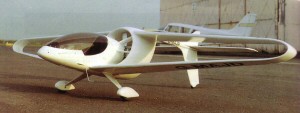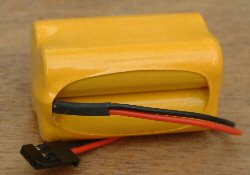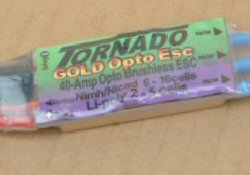|
|||
|
|
|
||
| View Shopping Cart |
| Home |
| Guides Available |
| About the Author |
| FAQs |
| Testimonials |
| Articles |
| Contact Andrew |
| Terms & Conditions |
| Mailing List |
| Links |
 |
 |
Get more high quality electric modeling information, absolutely free:
Sign up for the Gibbs Guides newsletter now!
Electric Flight Glossary
& discussion of electric flight terms
Part 3 - L to P
by Andrew Gibbs
There are many technical terms and words relating to model
aircraft in general, and electric flight in particular.
The aim of this detailed glossary is therefore to offer
an accurate and detailed yet concise explanation for any
of the terms the electric modeller is likely to come across.
Let us know if a term you'd like to see covered is not
discussed here!

LiPo/Li-Poly/Lithium battery
This is a modern type of battery and it is in almost
universal use for flying models. The nominal voltage
is 3.7 Volts per cell (Vpc). The absolute maximum
safe battery voltage is 4.2 Volts per cell, and the
minimum cell voltage before serious damage results
is 3.0 Volts per cell, under no load conditions.
LiPo batteries are light in weight, are capable of delivering a high current and are able to store relatively large amounts of energy. As a result, the combination of LiPo batteries and brushless motors have transformed electric flight. However, the disadvantages of this battery type are that they are relatively fragile and can burst into flames if abused, damaged in a crash or over charged. LiPo batteries are an excellent source of power for model aircraft provided they are used properly.
LiPo batteries are examined in more detail in this Gibbs Guide.
Li-Ion/Lithium Ion
This is another type of lithium-based cell, but these
are rarely used these days for electric power models.
Maximum charged voltage is 4.1 Volts per cell. They
have a hard case, and are therefore are physically
more durable than LiPo cells. They are also more resistant
to electrical abuse such as overcharging. However,
they are heavier than LiPo types, and do not have
such a high capacity for a given weight.
Lithium
Polymer (LiPo) batteries have transformed electric
flight in recent years. |
LiPo
batteries can catch fire if overcharged, as
seen here. (Photo courtesy of
Simon Sheldon) |
LVC (Low Voltage
Cut - Off)
This is another name given to the PCO function.
See the entry for 'Power Cut Off'.
mAh
The term mAh is an abbreviation for milli-Amp-hour,
which is used in battery terminology as unit of measurement
of battery capacity. 1,000 mAh equals 1 Amp hour.
For example a fully charged 3,000 mAh battery can
supply 3,000 mA (the same as 3 Amps) for one hour
before it is exhausted.
Motor losses
A well designed electric motor can achieve an impressive
efficiency. However, no electric motor is 100% efficient
as there will inevitably be losses of energy within
the motor. There are four causes of lost energy within
an electric motor, which are termed copper loss, iron
loss, air losses and friction losses. Each of these
losses is detailed separately within this glossary.
Nickel Cadmium (Nicad) cells
Nicad cells have a nominal voltage of 1.2 Volts per
cell. Compared to LiPo cells, nicads are heavy, and
have low capacity for a given weight. However they
are extremely durable. For many years nicads were
the only practical cell for use with electric power
aircraft and were in widespread use both as flight
packs and for RC power. However, because of the toxicity
of cadmium, nicad cells are no longer available. However,
due to their durability there are still a substantial
number of nicad packs in use in modeling applications,
especially for RC system power supply. For reasons
of safety, all batteries in safety critical applications
such as for RC system power supply duty should be
regularly inspected and tested before use.
Nicad
batteries are unfortunately no longer available
for modeling use. This is a pity as they were
more durable than hydrides, and had much to recommend
them. |
Opto
isolating ESCs cannot offer a BEC function. Models
equipped with opto isolating ESCs therefore need
a separate power supply for the RC system. |
NOS
The abbreviation is sometimes found in modeling discussions.
It simply stands for New Old Stock i.e. an unused, but
old item.
Opto isolator
Electric motors and ESCs inevitable generate an amount
of electrical noise. Because all the components of the
power system and the RC system are linked, there is
a tendency for this noise to be fed to the receiver,
compromising its performance.
To combat this problem, some ESCs use an opto isolator chip. Although the ESC is still connected to the receiver, the opto isolator feature allows the receiver to be electrically isolated form the ESC. Instead, the communication between the receiver and ESC is accomplished optically, using pulses of light in the manner of a fibre optic cable. This feature greatly reduces the amount of electrical noise which reaches the receiver.
Because there is no direct electrical connection between
the ESC and the receiver, the ESC cannot supply power
to the RC using a BEC function. The RC system must therefore
be supplied by a separate battery dedicated to RC system
power.
The
brushless outrunner motor is very popular for
electric power model aircraft. |
All
ESCs have a PCO function. This cuts power to the
motor at an appropriate point to prevent the battery
from becoming excessively discharged. |
Outrunner Motors
The outrunner motor is a design of brushless motor in
which the magnets are fixed to a rotating outer case.
The windings are located at the centre of the motor,
arranged around an inner (fixed) former. The magnets
run outside of these windings, hence the name of this
motor type. The propeller driver is attached to the
rotating outer case.
Outrunners have a relatively large diameter, and this characteristic naturally gives them a high torque, making them suitable to drive relatively large diameter, efficient props. This is the principal reason they are the usual choice for the majority of electric RC sport and scale models, as well as indoor 3D models and park fliers.
You can find a lot more information about brushless motors in the guide Mastering Motors, available here
PCO (Power Cut - Off)
PCO is the abbreviation given to the Power Cut Off function
of an ESC. The PCO detects when the battery voltage
falls to a user-defined threshold, and initiates a reduction
or shut down of power to the motor to prevent the battery
from falling to an unacceptably low voltage. If this
were permitted, the battery may become damaged and/or,
when RC system power is derived from the flight battery
via a BEC, control of the model could be lost.
Permanent Magnets
The permanent magnets used in brushed and brushless
motors have varying degrees of magnetic strength and
temperature resistance. Ferrite magnets are weakest,
while Samarium Cobalt and Neodymium types are substantially
stronger. Permanent magnets generally lose magnetic
strength as they are heated, but recover as they cool
down again. However, there is a temperature beyond which
the magnet will suffer a permanent loss of its magnetism.
Partially de magnetized motors cause the motor to draw significantly more current and generate more heat accompanied by a reduced power output. For these reasons, care must be taken not to allow electric motors to become excessively hot in use. In all cases, it is worth remembering that the outside of the motor case will be a lot cooler than the magnets inside, so a good rule of thumb is to make sure that the outside of the motor does not exceed 80-100C. The temperature of motors and other components can easily be measured after flight by means of a simple, cheap infra red thermometer.
Pitch
The pitch of a propeller is the forward distance the
prop will move, if there is no resistance to movement.
For example, a prop with a 6 inch pitch will theoretically
move forward 6 inches in one revolution.
Pitch to diameter ratio (p/d ratio)
The pitch to diameter ratio of a propeller is simply
the ratio of the prop’s pitch to its diameter.
For example, to find the p/d ratio a prop with a 12
inch diameter and a 6 inch pitch (12 x 6) the calculation
would be: p/d = pitch/diameter = 6/12 = 0.5. A 12 x
6 prop therefore has a pitch to diameter ratio of 0.5.
Similarly, a 10 x 8 has a p/d ratio of 0.8, a 8 x 6
has a ratio of 0.75 and so on.
The p/d ratio is of important significance when matching a prop to a model. Fast models should have props with a high p/d ratio e.g. 10 x 8, while slow models are best off with a much lower ratio, for example a 10 x 5.
Pitch speed
The pitch speed of a propeller is the speed it would
travel forwards if there was no resistance to its movement,
in other words, if no model was attached to it. The
pitch speed is found by multiplying the prop pitch by
the rpm:
Pitch speed = Prop pitch x Prop RPM
Pitch speed gives a useful indication of how well suited a particular power system is to a particular airframe. The pitch speed will always be higher than the airspeed of the model.
You can find a lot more information about props in the guide More Than Motors, available here
Power (Watts)
Power is a measure of the rate at which work is done.
Power can be either mechanical or electrical. Mechanical
power is usually measured in horsepower. The definition
of mechanical power is Power (hp) = Torque x RPM.
Electrical power is measured in Watts, or for larger amounts of power the kilowatt. A 0.40 capacity model engine typically develops about 1 hp, which is equivalent to 746W.
The power of an electric model aircraft is found by multiplying the voltage and the current:
Power (Watts) = Voltage x Current (Amps)
Propeller
The propeller, or prop for short converts the rotational
energy provided by the motor into thrust. The rotating
prop unavoidably also imparts a slight swirling motion
to the airflow. Larger props are more efficient than
smaller ones, and small increases in propeller diameter
can yield a relatively large increase in efficiency.
Prop driver
A prop driver is a device fitted to the output shaft
of a motor which is designed to allow easy attachment
of the propeller.
Prop drivers for outdoor models are usually of the collet type. These work well, giving a secure, solid fit. Occasionally a set screw type will be encountered, but these are best avoided. The prop driver must be correctly sized for the motor shaft diameter in question. Common motor shaft diameters are: 1.5mm, 2mm, 3mm, 3.17mm (1/8?), 3.2mm, 5mm and 6mm.
Prop saver
Low powered indoor models sometimes use a different
type of prop adapter, called a prop saver. These consist
of a metal adapter, designed to allow the prop to be
held on with a rubber band. This arrangement, which
is only suitable for very low power models, gives the
prop an increased measure of crash resistance.
Pusher prop
A pusher prop is one which is located behind the motor
driving it. The prop is said to push the model, rather
than pulling it as in a tractor installation. In spite
of this terminology, reality the propeller works in
exactly the same way regardless of whether it is in
a tractor or pusher configuration.
Click here for the next part of the glossary


